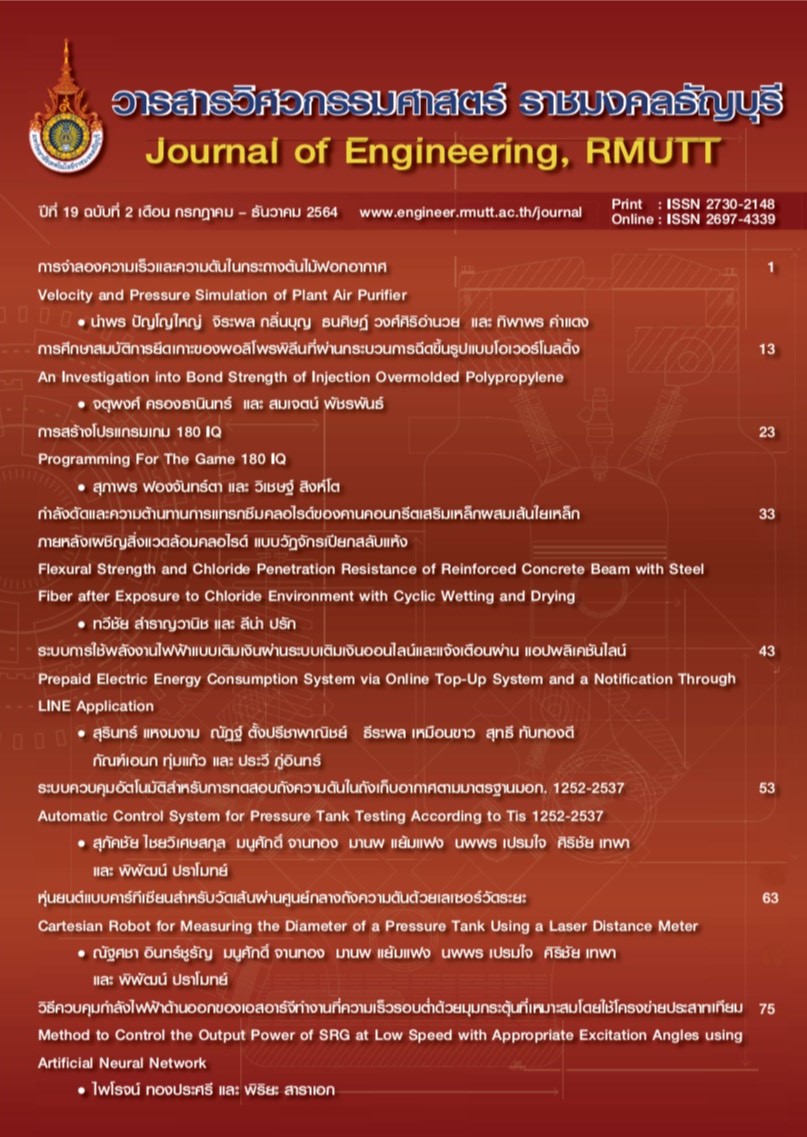Method to Control the Output Power of SRG at Low Speed with Appropriate Excitation Angles using Artificial Neural Network
Main Article Content
Abstract
Parameters of a switched reluctance generator (SRG) consist of DC bus voltage, rotor speed and excitation angles. When the DC bus voltage and rotor speed are constantly controlled, the output power of an SRG depends on the excitation angles. This paper presents a method for determining the appropriate excitation angles of an SRG using artificial neural network to generate the required output power, when the SRG operates at low speed. The artificial neural network used as a back-propagation type in combination with a Levenberg-Marquardt algorithm. The inputs used in the artificial neural network have two variables; rotor speed and output power. The desired output is the excitation angles. The data set for teaching artificial neural network was obtained from an experiment to collect the results of the output power and excitation angles at a constant speed between 1,000-2,000 rpm. Half bridge converter circuit is used to drive the SRG, which is processed by a dSPACE DS1202. The control program is designed through MATLAB/Simulink together with the ControlDesk program to control and display via the computer screen. The rotor speed and required output power were determined into the artificial neural network to predict the excitation angle. The experiment results, the output power generated by the SRG has an average error of 1.76% compared with the required output power. This result confirms the accuracy of the excitation angles processed by artificial neural network.
Article Details
The manuscript, information, content, picture and so forth which were published on Frontiers in engineering innovation research has been a copyright of this journal only. There is not allow anyone or any organize to duplicate all content or some document for unethical publication.
References
Li G.J. Zhang K, Zhu Z.Q, Jewell G.W. Comparative studies of torque performance improvement for different doubly salient synchronous reluctance machines by current harmonic Injection. IEEE Transactions on Energy Conversion. June 2019;34(2):1094-104.
Cardenas R, Pena R, Perez M, Clare J, Asher G, Wheeler P. Power smoothing using a flywheel driven by a switched reluctance machine. IEEE Transactions on Industrial Electronics. June 2006;53(4):1086-93.
Ferreira C.A, Jones S.R, Heglund W.S, Jones W.D. Detailed design of a 30-kW switched reluctance starter/generator system for a gas turbine engine application. IEEE Transactions on Industry Applications. June 1995;31(3):553-61.
Schofield N, Long S. Generator operation of a switched reluctance starter/ generator at extended speeds. IEEE Transactions on Vehicular Technology. Jan 2009;58(1): 49-56.
Chen H, Sun C, Wang Q. Analysis of flux-linkage characteristics of switched reluctance linear generator. IEEE Transactions on Applied Supercon-ductivity. June 2014;24(3):5000105- 5000105.
Choi D.A, Byun S.I, Cho Y.H. A study on the maximum power control method of switched reluctance generator for wind Turbine. IEEE Transactions on Magnetics. Jan 2014;50(1):4003004-4003004.
Sikder C, Husain I, Sozer Y. Switched reluctance generator control for optimal power generation with current regulation. IEEE Transactions on Industry Applications. Jan 2014;50(1):590-3.
Yu S, Zhang F, Lee D.H, Ahn J.W. High efficiency operation of a switched reluctance generator over a wide speed range. Journal of Power Electronics. Jan 2015;15(1):123-30.
Zan X, Huo Y, Gu J. Optimization research of turn-on angle and turn-off angle based on switched reluctance starter/generator system. IEEE 28th Canadian Conference on Electrical and Computer Engineering (CCECE). 2015:864-9.
Faiz J, Fazai R. Optimal excitation angles of a high speed switched reluctance generator by efficiency maximization. 12th International Power Electronics and Motion Control Conference. 2006:287-91.
Viajante G.P, Chaves E.N, Miranda L.C, Freitas M.A.A.d, Queiroz C.A.d, Santos Josemar A.d, Gomes L.C, Fidelis R.T. Design and implementation of a fuzzy control system applied to a 6 × 4 SRG. IEEE Transactions on Industry Applications. Jan 2021;57(1):528-36.
Asadi P, Ehsani M, Fahimi B. Design and control characterization of switched reluctance generator for maximum output power. Twenty-First Annual IEEE Applied Power Electronics Conference and Exposition. 2006;1639-44.
Xiong L, Xu B, Gao H, Xu L. A novel algorithm of switched reluctance generator for maximum power point tracking in wind turbine application. International Conference on Sustainable Power Generation and Supply. 2009:1-5.
Sozer Y, Torrey D.A. Closed loop control of excitation parameters for high speed switched-reluctance genera-tors. IEEE Transactions on Power Electronics. March 2004;19(2):355-62.
Babitha S, Kulkarni V, Koujalagi J.P. Vector control based speed and flux estimation in switched reluctance motor using ANN controller. 4th International Conference on Recent Trends on Electronics, Information, Communication & Technology. 2019:10-4.
Rahmanian E, Akbari H, Sheisi G.H. Maximum Power Point Tracking in Grid Connected Wind Plant by Using Intelligent Controller and Switched Reluctance Generator. IEEE Transac-tions on Sustainable Energy. Jul 2017;8(3):1313-20.
Miller T.J.E. Electronic Control of switched reluctance machines. Newnes Publisher. 2001.


